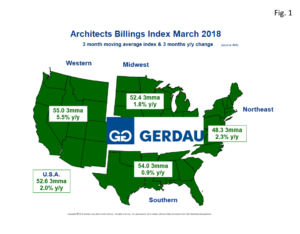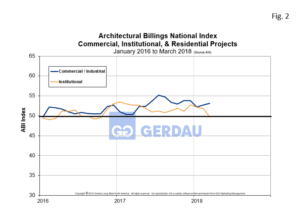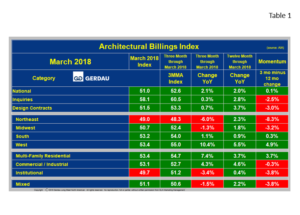Architectural Billings Index
March’s ABI national overall score of 51.0, down 1.0 point from February’s 52.0 but still well into the expansionary zone, (>50). Although business conditions in the northeast region softened, it remained strong in the West and South regions. The new projects inquiry index came in at 58.4, down 4.3 points from last month, while the new design contracts index decreased 3.0 points to 51.5. Regional monthly scores were: South 53.2, West 53.4, Midwest 50.7 and Northeast 49.0.
The Architecture Billings Index (ABI), is a leading economic indicator that provides an approximately nine to twelve month glimpse into the future of nonresidential construction spending activity. The results are seasonally adjusted to allow for comparison to prior months. Scores above 50 indicate an aggregate increase in billings, and scores below 50 indicating a decline.
 Figure 1 presents a map of the U.S. depicting the four ABI regions. It is color coded to show expanding billings and increased growth in green and declining billings and negative growth in red. The data is shown on this map is as three month moving averages (3MMA), and 3 month year on year (y/y), percent change.
Figure 1 presents a map of the U.S. depicting the four ABI regions. It is color coded to show expanding billings and increased growth in green and declining billings and negative growth in red. The data is shown on this map is as three month moving averages (3MMA), and 3 month year on year (y/y), percent change.
On a 3MMA basis, the national ABI score was 52.6 with a 2.0% annual growth rate. The Western region posted the highest 3MMA of 55.0 and a strong annual growth rate of 5.5%. The Southern region’s 3MMA ABI was 54.0, with an annual growth rate of 0.9%. The Midwest zone scored a 52.4, 3MMA, its annual growth rate was 1.8% y/y. The Northeast recording an ABI of 48.3 3MMA with an annual growth rate of 2.3%.
Figure 2 charts the ABI sub-index for Commercial / Industrial and Institutional from 2016 to present. The Commercial/Industrial sub-index increased by 0.4 point month on month to 53.1 in March, which is the first time in three months that it has been trending upwards. The good news is that the index has now been greater than 50 for 26 consecutive months. The Institutional sector is trending downward, scoring a 49.7, down 2.1 points m/m. March’s score marks the first time in 16th consecutive months that the institutional index has been less than 50.
charts the ABI sub-index for Commercial / Industrial and Institutional from 2016 to present. The Commercial/Industrial sub-index increased by 0.4 point month on month to 53.1 in March, which is the first time in three months that it has been trending upwards. The good news is that the index has now been greater than 50 for 26 consecutive months. The Institutional sector is trending downward, scoring a 49.7, down 2.1 points m/m. March’s score marks the first time in 16th consecutive months that the institutional index has been less than 50.
 Table 1 lists the overall ABI and all of its sub-indexes. It presents and compares monthly and 3MMA data, showing percentage point change on both three and 12 month basis, as well as momentum. Green denotes positive change, while red indicates negative growth. National momentum, (3 month y/y subtract 12 month y/y) was slightly negative, at -0.9%.
Table 1 lists the overall ABI and all of its sub-indexes. It presents and compares monthly and 3MMA data, showing percentage point change on both three and 12 month basis, as well as momentum. Green denotes positive change, while red indicates negative growth. National momentum, (3 month y/y subtract 12 month y/y) was slightly negative, at -0.9%.
Inquiries momentum was negative 2.5%. Design contract momentum declined 3.0%. Regionally, momentum was mixed with two of the four zones posted positive momentum; The Northeast recorded negative 8.3% momentum, while the Midwest recorded a negative 3.2% momentum. The South’s momentum was positive 0.3% as the West posted momentum was positive 4.9%. Momentum for the remaining project categories was mixed: Multi-family residential, (+3.7%), Commercial / Industrial, (-0.3%), Institutional, (-3.8 %) and Mixed-use, (-3.8%).
In its release today, AIA Chief Economist, Kermit Baker, Hon. AIA, PhD, quoted the following: “New project activity coming into architecture firms continues to grow at a solid pace. As a result, project backlogs – in excess of six months at present- are at their highest post-recession level.”
At Gerdau we follow the ABI because it is a leading indicator of non-residential construction activity with an approximate 12 month lead-time to ground-breaking. The ABI has a proven track record and as such it is useful for business planning purposes.

